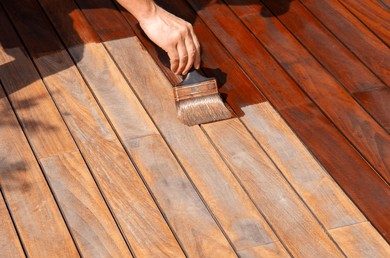Staining a deck during a Texas summer is possible, but the extreme heat and sun bring unique challenges. If done incorrectly, staining in high temperatures can lead to premature drying, uneven color, and poor adhesion—wasting time and money.
This guide covers everything you need to know about deck staining in Texas heat, including:
✅ Best temperatures for staining a deck
✅ How to prep & stain in hot weather
✅ Which stains work best for Texas summers
✅ Common mistakes to avoid
✅ When to hire a professional deck staining service
| Factor | Optimal Range | Texas Summer Reality |
|---|---|---|
| Temperature | 50°F–85°F | 90°F–110°F |
| Humidity | 40–70% | 20–50% (dry heat) |
| Direct Sunlight | None | Intense UV exposure |
Key Problem:
Stain applied in >90°F weather can:
✔ Dry too fast → brush marks & lap lines
✔ Fail to penetrate wood → peeling within months
✔ Cure unevenly → blotchy appearance

Best: Early morning (6 AM–10 AM)
Second Option: Late evening (after 7 PM)
Avoid: Midday (11 AM–5 PM)
Pro Tip: Check the real-feel temperature, not just the forecast—direct sun can make surfaces 20°F hotter than air temps.
Best Types for Texas Heat:
Oil-Based Semi-Transparent (penetrates better in heat)
Acrylic Hybrids (flexible to resist cracking)
Water-Based with UV Inhibitors (less prone to rapid drying)
Avoid in Summer:
❌ Solid-color stains (show application errors more)
❌ Cheap thin stains (evaporate before soaking in)
Clean Thoroughly
Pressure wash (use fan tip, 1,500–2,000 PSI)
Apply deck cleaner for mildew/stains
Let Dry 48+ Hours (critical in humidity under 50%)
Sand Rough Areas (80-grit for splinters)
Texas-Specific Tip: If wood feels hot to the touch, mist with water to cool it before staining.
Work in Small Sections (4–6 boards at a time)
Use a Brush + Roller Combo (better than spray-only)
Maintain a Wet Edge (prevents lap marks)
Avoid Over-Application (puddles bake into sticky spots)
| Product | Type | Why It Works |
|---|---|---|
| Ready Seal | Oil-Based | Self-leveling, forgiving in heat |
| TWP 1500 Series | Oil Hybrid | Deep penetration, UV-resistant |
| Cabot Australian Timber Oil | Oil-Based | Heat-tolerant, rich color |
| Behr Premium Semi-Transparent | Water-Based | Quick dry time, UV protection |
Result: Stain dries in 10–15 minutes (vs. 30+ mins needed)
Fix: Wait for cooler temps or shade the deck with tarps.
Mistake: Assuming wood is dry after washing
Texas Fix: Use a moisture meter (<15% moisture content before staining)
Avoid: Foam rollers (overheat and disintegrate)
Use: Synthetic brushes + microfiber rollers
Consider pros if:
✔ Your deck is large or multi-level
✔ You need same-day staining (crews start at dawn)
✔ The wood is old or heavily damaged
✔ You want a warranty (1–3 years typical)
Cost Comparison:
DIY: $0.50–$1.50/sq.ft. (materials only)
Pro: $2.50–$4.50/sq.ft. (labor + materials)
Value Added: Pros have commercial-grade stains not sold at retail stores.
Best Months in Texas: October–November
Advantages:
Mild temps (60°F–80°F)
Lower UV index
Option: Clear sealer + light pigment
Pros: Less temperature-sensitive than stain
Cons: Less UV protection
Install a pergola or awning
Stain under cover (reduces surface temp by 15°F+)
Yes, but only if:
You follow early morning/late evening timing
Use high-quality, heat-tolerant stain
Prep the deck meticulously
Better to hire pros? If you’re unsure, a professional deck staining service ensures:
✔ Proper prep (sanding, cleaning)
✔ Even application (no lap marks)
✔ Long-lasting results (2–5 years vs. 1–2 for DIY errors)